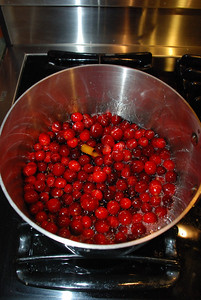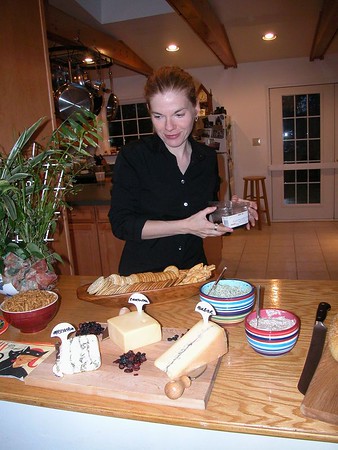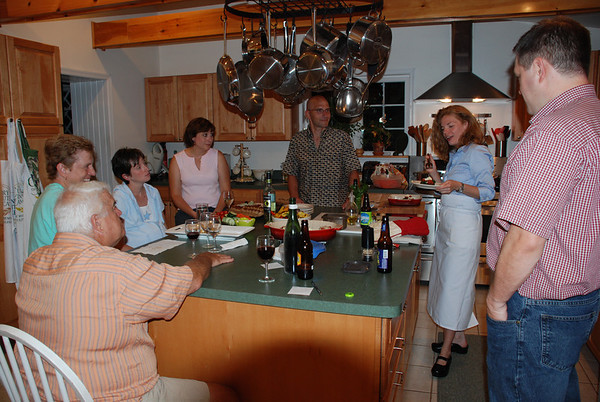
Meatballs. Vodka. Pickled herring. Lox. Not the best of Sweden’s cuisine but what came to my friends’ minds when invited for ”a night of Swedish delights. ” Quirky and authentic were what they had learned to expect when dining with me.
In recent years this daring group has endured countless recipe testing sessions, including “Dessert Night Number One” with its soupy lime-and-mint granita and “An Evening of Three Tajines.” On that cold winter night my tajine-testing friends were transported to sunny, sandy Morocco. Zeye Mayel’s “Nass Marrakech” blared from the stereo. Hot mint tea spilled out of tall, silver teapots and into painted, filigreed glasses. A red, silk blanket, purchased at a souk in the seaside town of Essaouira, covered the dining room table.
Lined up on the green Formica kitchen counter were tagines of chicken, preserved lemons and olives, charmoula-covered cod and chickpeas and root vegetables. Prior to setting foot in my house, not one person had seen, much less heard of, these clay, conical-lidded pots. Yet, this bold quintet — Connie, Sharon, Mike, John and my husband Sean — dug into these unusual foods without any hesitation.

Recipe testing defies all rules of entertaining. Usually, when you invite people over for dinner, you serve tried and true dishes. Not so with this activity. I offer up an assortment of odd meals, most of which have been conjured up only days or hours beforehand. Many are based upon something that I ate 20 years ago in a friend’s kitchen, at a European sidewalk cafe or from a roadside stand.
Typically these meals have an international, often Mediterranean flavor. A few feature unheard of ingredients – charmoula, lingonberries, ramps and haloumi cheese. (As another nod to my recipe testers, many have grown up in East Coast suburbs where dumplings invariably contain apples and the cheese steak is king. No wonder a few raise their eyebrows at an evening of chilled foods such as ajo blanco, the Spanish garlic-almond-bread soup.)

Get past the strange ingredients and you still have to deal with the utter failure of a recipe or two. At September 2007’s “Feast of Fungus” I made a last-minute addition to the menu. Spinach-stuffed portobello mushrooms had been part of my culinary repertoire for close to a decade. Marinated in garlic, thyme, lemon juice, and olive oil and topped with spinach, chopped tomatoes and fontina cheese, they had never failed to please. That night, however, I was in a hurry. As a result, I knocked over the marinade and had to add more liquids to the mix. Guessing at the amounts, I poured in a little olive oil and a splash of concentrated, organic lemon juice. Marinade fixed, I assumed.
One bite and our mouths puckered. So much for that splash of lemon juice. What once was an earthy entree had become a piquant, lemon-saturated disaster.

Want a little danger, a little drama in the kitchen? Try forgetting to remove your frying pan from the heat before deglazing it with vodka. Not only did I catch the pan on fire but also did I cause the kitchen cabinets go up in flames. Did I mention that these were new cabinets or that we were about to put our house up for sale? You never hear about Nigella Lawson doing something as dangerous or absent-minded as this.
Craving blood or burned flesh? Consider the night where, once again, I was in a rush, trying to roast two tarragon-infused chickens before we all fell asleep at the dinner table. After removing one of the racks – preheated to 400 degrees Fahrenheit — from the oven and placing it on top of the stove, I then lowered the roasting pan so that it was closer to the heat source. Rising up, I lurched forward, bumping my forehead against, yep, the searing hot oven rack. Applications of a bag of frozen peas followed by baggies of ice cubes could not spare me from a blistered, two-days-before Thanksgiving bruise.
Perhaps this is why my brave buddies continue to sign on for these recipe testing and international cuisine-themed nights. Dinner and drama, all for free. Then again, it might just be the chance to sample the world’s cuisines.
Moroccan Tagine of Cod, Potatoes, Green Peppers, Tomatoes and Olives
Serves 6
This tagine can be made with red snapper, monkfish or any other firm, white fish and is seasoned with the Moroccan spice-and-herb mixture, charmoula.
Ingredients for the charmoula:
6 cloves garlic, peeled and quartered
1 ½ teaspoon crushed chili pepper
1 teaspoon ground cumin
1 teaspoon salt
½ teaspoon paprika
generous handful of cilantro, washed and stems removed
handful of parsley, washed and stems removed
juice of 1 ½ lemons
2 ½ tablespoons olive oil
ground black pepper to taste
Using a food processor, pulse all the ingredients together until they have formed a paste. Alternately, you can use a mortar and pestle and combine the garlic with the chili and black pepper, cumin, paprika, cilantro and parsley. Add the oil and lemon juice at the end.
Ingredients for the tagine:
3 pounds of cod, trimmed and cut into small chunks
charmoula (see above)
4 tablespoons olive oil
3 large potatoes, peeled and thinly sliced
2 green bell peppers, seeded and cut into strips
1 pint cherry tomatoes
5 cloves garlic, peeled and thinly sliced
2 tablespoons tomato paste
¾ cup water
handful of kalamata olives
salt and pepper to taste
Place the chucks of fish onto a large platter. Spread the charmoula over the fish, cover, and refrigerate for an hour.
Heat the olive oil in the tagine then add the potatoes, stirring frequently so that they don’t stick or burn. Cook on medium heat until softened – roughly 10 minutes – then add the peppers. Cover and cook for another 5 minutes, frequently checking the vegetables.
Mix together the tomato paste with warm water. Pour the mixture over the potatoes and peppers. Add the cherry tomatoes, cover, and cook for another 10 minutes.
Lay the chunks of cod on top of the vegetables. Add any remaining charmoula and the salt and pepper to the pot. If the sauce appears too reduced, pour in water as needed.
Cover and cook the stew for approximately 15 minutes or until the fish appears done. Add the kalamata olives. Simmer for another 3-5 minutes then serve.
Spanish Ajo Blanco
Serves 4 to 6
Ingredients:
7 ¼ ounces blanched almonds
4 cloves of garlic, skins removed
1 slice of stale, white bread, crusts removed
½ teaspoon salt
3 tablespoons extra virgin olive oil
2 ¼ cups ice water
1 teaspoon sherry vinegar
1/8 teaspoon freshly ground white pepper
handful of green grapes, cut in half lengthwise
dash of paprika
Place the almonds, garlic, bread, salt and olive oil in a blender or food processor and process until ingredients are finely chopped.
Leaving the food processor or blender running, slowly add the ice water. If the soup appears too thick, add more water as needed. The ultimate consistency should be creamy but not thin or runny.
Add the sherry vinegar and white pepper to the soup and pulse a few times.
Pour into a container or soup tureen and refrigerate until chilled.
Ladle the ajo blanco into bowls and delicately place several halved grapes and a sprinkle of paprika on top of each soup. Serve immediately.